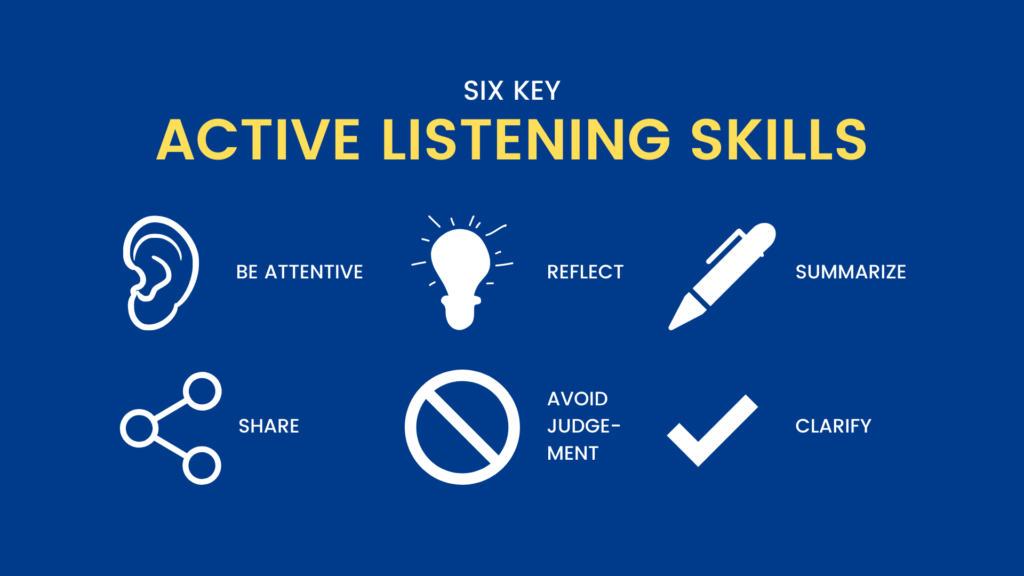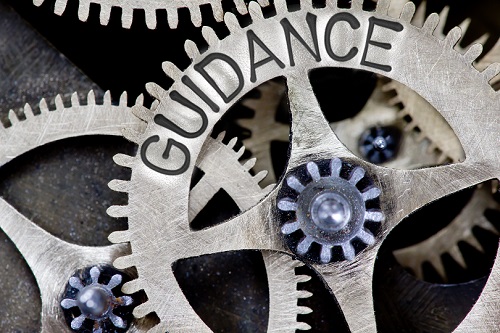- What is Active Listening?
- Verbal Active Listening Techniques
- Non-Verbal active listening skills
- Purpose of Active listening
- Benefits of Active listening
- Difference between active and passive listening
- Tips for practising Active listening skills
What is Active Listening?
In simple words, we can define Active listening skill as a soft skill in which a person listens attentively while someone else is speaking, paraphrasing, and reflecting on what is said. This helps you to make other people feel heard and valued. We can name active listening skills as the foundation for any successful conversation. It uses verbal and non-verbal techniques. According to the research of 2011, it was found that active listening skills are associated primarily with verbal social skills rather than nonverbal skills.
Active listening looks like teamwork, sounds like an idea is shared at a time, and feels like you are being heard.
On your route to mastering this skill, you can also explore free professional courses designed and delivered by industry experts. These free courses will help you build essential skills required to power ahead your career.
Verbal Active Listening Techniques
1. Paraphrase – summarizing the message the speaker shared will allow the speaker to clarify the information or expand their message it will also help you to fully understand their meaning.
2. ASK open-ended Questions – these questions show that you have gathered the essence of what they've shared and can guide them in sharing more information with you. These questions should not be answered with a simple yes, or no. For example –"you're right- the onboarding needs some updating. What are the changes you would like to make to this process over the next six months"?
3. Ask specific probing questions – these are often called direct questions.it guides the reader so that he/she can provide more details about the information that they have shared. Example- "Tell me about your workload. Which of these projects are more time-consuming?"
4. Using short verbal affirmations – is used to make the speaker feel more comfortable and show that you're engaged and can process the information that he is delivering. These affirmations are Short and positive. This will help you to continue the conversation without interrupting or disrupting their flow. Example – "I Understand.", "I agree", "OH! I See ", etc.
5. Displaying empathy – showing compassion rather than just feeling it will connect you with the speaker and will help you in establishing a sense of mutual trust. Make sure that the speaker can understand that you're able to recognize their emotions and share their feelings. Example -"I am sorry you're dealing with this problem, let's figure out some ways I can help."
6. Share similar Experiences – this will show the speaker that you have successfully interpreted their message. This can also help you in building relationships. For example – The speaker has shared with you the XYZ problem and you provided input on how to solve a similar problem you were facing
7. Recalling previously shared information – try to remember the important points, concepts, and ideas that the speaker has shared with you in the past. This will make the speaker understand that you are not only listening but are also able to retain the information and recall the specific details.
Also Read: What are transferable skills?
Non-Verbal active listening skills
1. Nods – during the conversation a few simple nods will show the speaker that you understand what they are saying and encourage them to share the information further. This shows that you can process the meaning of their message.
2. Smile– like a nod, smile also encourages the speaker to continue. This can often signify that you are happy about what they have to say. In some cases, it can be assumed that you agree with their message or thought. This can also take place in short verbal affirmation so that the speaker feels comfortable.
3. Avoid distracting Movements- you can do this by trying to avoid movements like glancing at the watch or the cell phone, doodling, or tapping a pen. Try to avoid an exchange of verbal and non-verbal communication as this will make the speaker feel frustrated and uncomfortable.
4. Maintain eye contact – try to avoid looking at objects and other people in the room. Keep an eye on the speaker just be sure that you don't stare and keep the gaze natural, using nods and a smile to ensure you are encouraging them rather than making them uncomfortable or uneasy.
By following these verbal and non-verbal techniques you can develop strong relationships and retain more information. Although Active listening can only be developed by practicing the techniques. The more likely you are trying to use these techniques the more natural they will feel.
Purpose of Active listening
Active listening has the purpose of earning the trust of others and understanding their situation and perspective. It comprises both the desire to comprehend and to offer empathy and support to the speaker though it differs from critical listening because in this you are not evaluating the message of the other person to be heard by the other person and perhaps to solve their problem.
Active listening means not trying to engage in unhelpful listening habits like not showing respect for the speaker, interrupting, not making eye contact, becoming distracted, etc.
Tip: If you find it difficult to focus on what an individual is saying to you, repeating their words mentally may help reinforce their message and allow you to focus.

Benefits of Active listening
As we know, active listening is an important skill. Let's look at some benefits of active listening.
1. Relationships – Active listening has many benefits in a relationship. It allows you to understand other people and respond to them with empathy. Also, it lets you ask questions to make sure that you understand what is being said. Moreover, it will make the speaker speak longer where the conversation is more about your partner than about you.
In case your partner is going through a tough time it will be helpful and valuable to your partner and the relationship. Here the goal won't be to be heard and to solve only your problem so it is less likely to jump in a "quick fix".
2. Social situations – Active listening will help you to meet new people and learn more about them by asking questions, seeking clarification, and watching body language. The newly met people can turn into friends as when you listen actively the other person is also likely to speak to you for a longer time.
3. Work – active listening plays an important role if you are in a supervisory position or you want to interact with colleagues or clients.it will help you to understand the collaboration to develop solutions. This also reflects your patience.it helps you build connections as active listening will make the other person comfortable with you and share information with you.
When you sincerely listen to what others say they will also be interested in communicating with you on a regular basis this will lead to the opening of opportunities. It also helps you to increase your knowledge and understand various topics and also helps you to avoid missing critical information when you can speak.
Also Read: 5 Teamwork skills you should know!
Difference between active and passive listening
| Basis of Comparison | Active Listening | Passive Listening |
| Process | Interactive | Mechanical |
| Involves | Reacting while listening to the speaker | Listening to the speaker without reacting |
| Communication | Two-way communication | One-way communication |
| Feedback | Present | Not Present |
| Non-verbal cues by the listener | Showing interest by nodding, smiling, changes in facial expressions, etc. | Showing no signs of interest, yawning, rolling your eyes, etc. |
Tips for practising Active listening skills
1. Paying attention – giving the speaker individual attention and acknowledging the message. You can do this by looking at the speaker directly, putting aside distracting thoughts, avoiding getting distracted by environmental factors, and listening to speakers' body language. This also includes making eye contact where you should aim for an eye contact of about 60% to 70%.
2. Defer judgment – interrupting frustrates the speaker and limits the full understanding of the message. You can do this by allowing the speaker to finish each point before asking any question or not interrupting with counterarguments.
3. Using the verbal and non-verbal sign of listening – in this you can use your body language and gestures to show that you are engaged for ex- nodding occasionally, encouraging speakers with small verbal comments, making sure that your posture is open, and interesting, etc.
4. Feedback – being a listener your role is to understand what is being said. This can require you to reflect on what is said. Some of the great ways to reflect are "what I am hearing is ......." and "Sounds like you are saying .........."
5. Questioning – it is one of the ways to show that you are listening to the speaker. You can ask questions to clarify certain points that are said by the speaker. You can use "what do you mean when you say….." or "Is this what you mean?" while questioning.
6. Summarizing – you can summarize the speaker's comment periodically
7. Avoiding abruptly changing the subject – this will reflect your inattentiveness towards the conversation
8. Body language - lean a little towards the other person and nod your head occasionally this shows that you are interested in the conversation. Try to avoid folding arms as this will signal that you are not listening.
9. Avoid daydreaming – one cannot focus or listen to someone else and their internal voice at the same time.
10. Learn to recognize active listening – you can do this when you are having a conversation with someone or you can watch telephone interviews and observe the interviewer whether he /she is practicing the active listening skills. You can learn from the mistakes of others.
Also Read: What are interpersonal skills?






